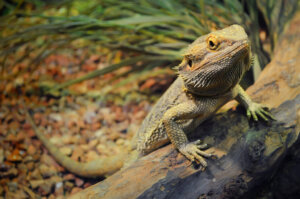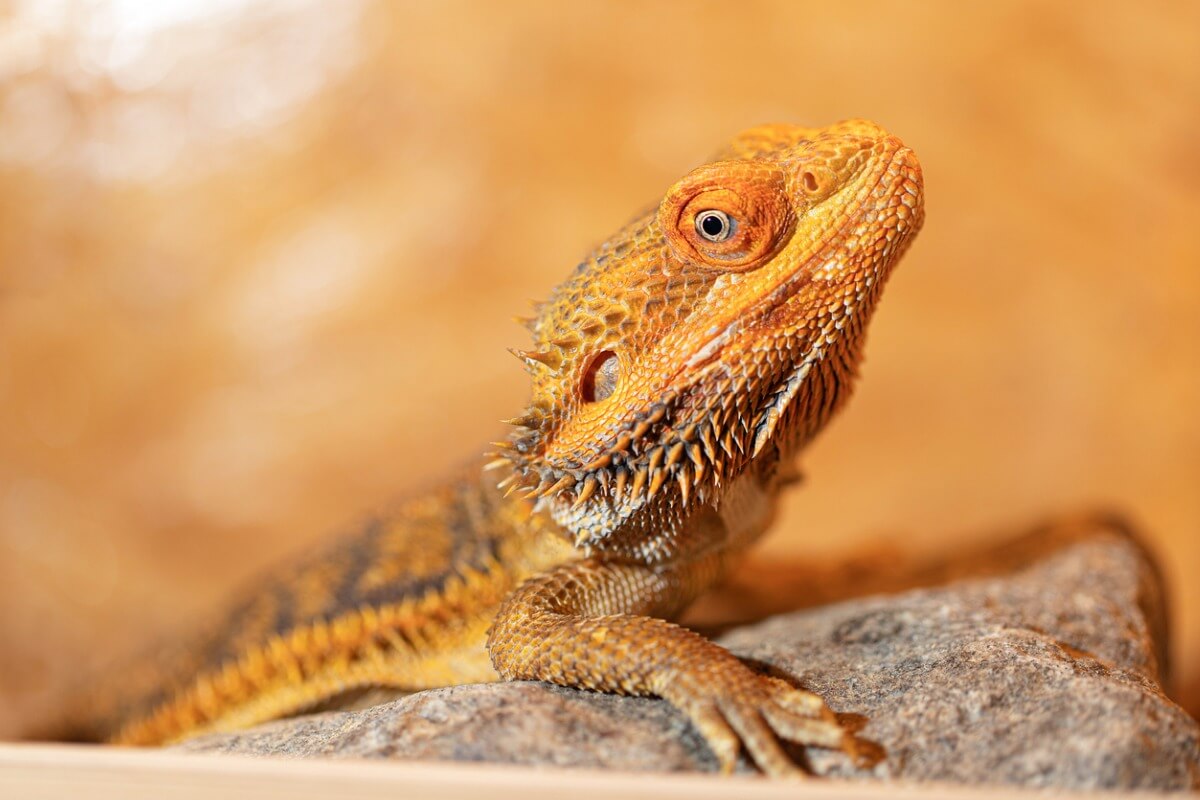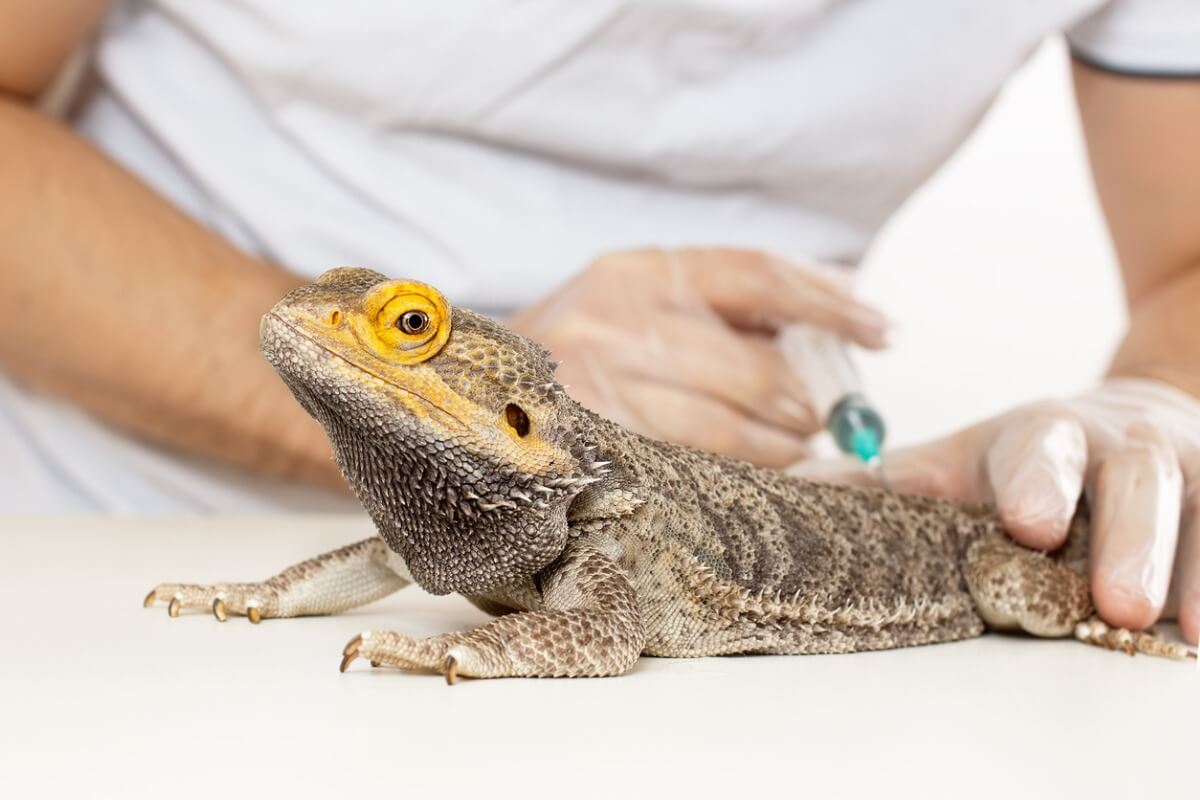10 Signs that Your Pogona Is Going to Die


Written and verified by the biologist Cesar Paul Gonzalez Gonzalez
The bearded dragon or pogona is an amazing reptile with a peculiar spiny appearance. It has a docile temperament and a wonderful appearance, which is why it has become a popular exotic pet. Of course, it needs special care and attention in captivity, since any carelessness could put its life at risk.
Detecting problems in the health of reptiles isn’t an easy task, since in many cases the warning signs are not so noticeable. For this reason, diseases often worsen and the animal is put at risk. Although in many cases not much can be done to prevent a fatal outcome, there are some signs that indicate that your pogona could die soon. Discover some of them in this article.
Warning signs in the pogona

Animals don’t have the ability to communicate in the same way as humans, so it’s difficult to identify their symptoms during an illness. This causes most owners to overlook warning signs in their pets. As a result, serious life-threatening problems could be caused and they may even die.
Although reptiles don’t usually express themselves too much, some specimens such as the pogona exhibit certain signs when they’re on the verge of death.
Although it may seem unbelievable, in such scenarios it’s still possible to do something to save their lives, but immediate action is needed and a specialized veterinarian should be consulted. The following list compiles some of the most important warning signs to keep in mind.
1. Weight loss
Weight loss is one of the signs in the pogona that indicates problems with its health, as its body isn’t able to assimilate nutrients well and could even die. Consequently, its immune system starts to fail and cannot cope with pathogens. All this will weaken the pet’s body considerably and eventually leads to death.
As medium-sized animals, they can withstand some weight loss. However, they require immediate veterinary attention to correct their health. The average weight of an adult pogona ranges from 300 to 450 grams, so any measurements below these parameters should be checked by an animal health professional.
2. Absence of feces
Feces are one of the best ways to identify if there’s a problem with reptile health. For this reason, the simple fact that no feces appear in the pogona’s habitat is one of the signs that it may be dying. This situation is usually an indication of a condition called intestinal impaction, which consists of an obstruction of the intestines that prevents the evacuation of feces.
This condition is quite dangerous and should be attended to as soon as possible, since the pressure of the obstruction could cause a rupture of the intestine and the death of the pogona. You can detect this problem by lightly palpating the belly of the pogona. If the lower region feels a little hard and there is no evidence of feces for several days, see a veterinarian immediately.
3. Sunken eyes
Sunken eyes in the pogona indicate a serious state of dehydration. This condition can be caused by various pathologies or neglect in the maintenance of the pet. However, the appearance of this warning sign means that the situation has become complicated and veterinary attention is necessary.
It’s normal to observe this problem in conjunction with weight loss, which often increases the severity of the condition. There are several home methods to rehydrate the pet such as adding a container with water in the habitat or increasing the humidity without exceeding 40%. Despite this, it’s always advisable to visit a veterinarian first so that you have the proper treatment.
4. Lethargy
Lethargic pogonas are characterized by remaining static for a long time. In addition, they avoid going out to explore their environment and don’t even go out to sunbathe. This condition may be caused by a low temperature in their habitat. However, if you’re sure that this isn’t the case, it probably means a problem in the pet’s health.
A reptile’s inactivity appears due to a lack of energy and muscle weakness. Therefore, it is often present when there is some pathological process affecting its body. Keep in mind that the situation can easily worsen and put the pogona’s life at risk. So when you detect this warning sign, go immediately to an animal health professional.
5. Apathy
Apathy is characterized by a lack of reaction to stimuli such as food, petting, handling or loud noises. When there’s no response from the pogona, it’s most likely to be sick and vulnerable. Although not all pathologies carry an imminent risk, weakness is a symptom that can worsen and lead to sudden death.
6. Different-looking feces
As mentioned above, feces are one of the most efficient ways to detect problems in reptiles. A change in the texture, color, appearance or smell of the stool is a warning sign, as this is usually caused by intestinal parasites or infections. Although both seem harmless, there are exceptions that could result in death.
Different-looking feces usually appear before other dangerous symptoms such as weight loss, sunken eyes, listlessness and lethargy. Therefore, if you notice that your pogona’s droppings are wetter or have a different color, see a veterinarian immediately.
7. Loss of appetite
Loss of appetite isn’t usually considered a dangerous sign, as it can be caused by any number of reasons. In fact, if the habitat doesn’t meet the optimal parameters for the species or if their location is changed, the pogona may become stressed and stop eating. Therefore, before jumping to conclusions, check that the conditions of its home are adequate.
If you have checked all of the above and your reptile doesn’t recover its normal appetite, it’s most likely to have a health problem. In this type of situation, don’t hesitate and go immediately to an animal health professional. Malnutrition leads to weight loss and immune system deficiency, so its life could soon be at risk.
8. Body lumps
Any lump on the pogona’s body signifies a serious health problem, as it’s one of the signs that it could die soon. These lumps are caused by tumors, cysts or parasites. Despite the fatalistic reputation that most of the above causes have, not all cases correspond to a lethal or unsolvable problem. However, the latter can only be determined by a veterinarian.
9. Breathing complication
One of the most frequent and lethal pathologies affecting reptiles are those of the respiratory system. The major conflict with them is that they go unnoticed for a long time, so most cases are detected when they have become too severe. Consequently, sometimes you can’t do anything to save them.
If you notice that your pogona makes noises when breathing or opens its mouth when inhaling, it’s very likely to be suffering from this type of disease. Therefore, go immediately to an animal health professional for a check-up.
The prognosis for these problems is difficult to tell, as it changes depending on the pathogen and the progress of the infection. Of course, there’s a better chance that the pet will recover if you see a professional soon.
10. Loss of skin color

Pogonas usually show intense colorations, which make the species very striking. For this reason, if duller tones appear or the brightness of its body decreases, it’s a sign that the specimen has a serious illness. So, when you detect a change in your pet’s physical appearance, see a veterinarian soon.
Remember that an animal’s traits are supported by the nutrients in its diet. This means that any change in the pet’s appearance implies an internal metabolic problem. Consequently, the pogona’s immune system is compromised and it’s likely to die if left unattended.
Although the above signs are helpful in recognizing serious problems in the pogona, the best option is always to see a veterinarian for any unusual symptoms. The behavior of pets can provide a lot of information about them, so you should pay close attention to them in order to detect danger in time and even save their lives.
The bearded dragon or pogona is an amazing reptile with a peculiar spiny appearance. It has a docile temperament and a wonderful appearance, which is why it has become a popular exotic pet. Of course, it needs special care and attention in captivity, since any carelessness could put its life at risk.
Detecting problems in the health of reptiles isn’t an easy task, since in many cases the warning signs are not so noticeable. For this reason, diseases often worsen and the animal is put at risk. Although in many cases not much can be done to prevent a fatal outcome, there are some signs that indicate that your pogona could die soon. Discover some of them in this article.
Warning signs in the pogona

Animals don’t have the ability to communicate in the same way as humans, so it’s difficult to identify their symptoms during an illness. This causes most owners to overlook warning signs in their pets. As a result, serious life-threatening problems could be caused and they may even die.
Although reptiles don’t usually express themselves too much, some specimens such as the pogona exhibit certain signs when they’re on the verge of death.
Although it may seem unbelievable, in such scenarios it’s still possible to do something to save their lives, but immediate action is needed and a specialized veterinarian should be consulted. The following list compiles some of the most important warning signs to keep in mind.
1. Weight loss
Weight loss is one of the signs in the pogona that indicates problems with its health, as its body isn’t able to assimilate nutrients well and could even die. Consequently, its immune system starts to fail and cannot cope with pathogens. All this will weaken the pet’s body considerably and eventually leads to death.
As medium-sized animals, they can withstand some weight loss. However, they require immediate veterinary attention to correct their health. The average weight of an adult pogona ranges from 300 to 450 grams, so any measurements below these parameters should be checked by an animal health professional.
2. Absence of feces
Feces are one of the best ways to identify if there’s a problem with reptile health. For this reason, the simple fact that no feces appear in the pogona’s habitat is one of the signs that it may be dying. This situation is usually an indication of a condition called intestinal impaction, which consists of an obstruction of the intestines that prevents the evacuation of feces.
This condition is quite dangerous and should be attended to as soon as possible, since the pressure of the obstruction could cause a rupture of the intestine and the death of the pogona. You can detect this problem by lightly palpating the belly of the pogona. If the lower region feels a little hard and there is no evidence of feces for several days, see a veterinarian immediately.
3. Sunken eyes
Sunken eyes in the pogona indicate a serious state of dehydration. This condition can be caused by various pathologies or neglect in the maintenance of the pet. However, the appearance of this warning sign means that the situation has become complicated and veterinary attention is necessary.
It’s normal to observe this problem in conjunction with weight loss, which often increases the severity of the condition. There are several home methods to rehydrate the pet such as adding a container with water in the habitat or increasing the humidity without exceeding 40%. Despite this, it’s always advisable to visit a veterinarian first so that you have the proper treatment.
4. Lethargy
Lethargic pogonas are characterized by remaining static for a long time. In addition, they avoid going out to explore their environment and don’t even go out to sunbathe. This condition may be caused by a low temperature in their habitat. However, if you’re sure that this isn’t the case, it probably means a problem in the pet’s health.
A reptile’s inactivity appears due to a lack of energy and muscle weakness. Therefore, it is often present when there is some pathological process affecting its body. Keep in mind that the situation can easily worsen and put the pogona’s life at risk. So when you detect this warning sign, go immediately to an animal health professional.
5. Apathy
Apathy is characterized by a lack of reaction to stimuli such as food, petting, handling or loud noises. When there’s no response from the pogona, it’s most likely to be sick and vulnerable. Although not all pathologies carry an imminent risk, weakness is a symptom that can worsen and lead to sudden death.
6. Different-looking feces
As mentioned above, feces are one of the most efficient ways to detect problems in reptiles. A change in the texture, color, appearance or smell of the stool is a warning sign, as this is usually caused by intestinal parasites or infections. Although both seem harmless, there are exceptions that could result in death.
Different-looking feces usually appear before other dangerous symptoms such as weight loss, sunken eyes, listlessness and lethargy. Therefore, if you notice that your pogona’s droppings are wetter or have a different color, see a veterinarian immediately.
7. Loss of appetite
Loss of appetite isn’t usually considered a dangerous sign, as it can be caused by any number of reasons. In fact, if the habitat doesn’t meet the optimal parameters for the species or if their location is changed, the pogona may become stressed and stop eating. Therefore, before jumping to conclusions, check that the conditions of its home are adequate.
If you have checked all of the above and your reptile doesn’t recover its normal appetite, it’s most likely to have a health problem. In this type of situation, don’t hesitate and go immediately to an animal health professional. Malnutrition leads to weight loss and immune system deficiency, so its life could soon be at risk.
8. Body lumps
Any lump on the pogona’s body signifies a serious health problem, as it’s one of the signs that it could die soon. These lumps are caused by tumors, cysts or parasites. Despite the fatalistic reputation that most of the above causes have, not all cases correspond to a lethal or unsolvable problem. However, the latter can only be determined by a veterinarian.
9. Breathing complication
One of the most frequent and lethal pathologies affecting reptiles are those of the respiratory system. The major conflict with them is that they go unnoticed for a long time, so most cases are detected when they have become too severe. Consequently, sometimes you can’t do anything to save them.
If you notice that your pogona makes noises when breathing or opens its mouth when inhaling, it’s very likely to be suffering from this type of disease. Therefore, go immediately to an animal health professional for a check-up.
The prognosis for these problems is difficult to tell, as it changes depending on the pathogen and the progress of the infection. Of course, there’s a better chance that the pet will recover if you see a professional soon.
10. Loss of skin color

Pogonas usually show intense colorations, which make the species very striking. For this reason, if duller tones appear or the brightness of its body decreases, it’s a sign that the specimen has a serious illness. So, when you detect a change in your pet’s physical appearance, see a veterinarian soon.
Remember that an animal’s traits are supported by the nutrients in its diet. This means that any change in the pet’s appearance implies an internal metabolic problem. Consequently, the pogona’s immune system is compromised and it’s likely to die if left unattended.
Although the above signs are helpful in recognizing serious problems in the pogona, the best option is always to see a veterinarian for any unusual symptoms. The behavior of pets can provide a lot of information about them, so you should pay close attention to them in order to detect danger in time and even save their lives.
All cited sources were thoroughly reviewed by our team to ensure their quality, reliability, currency, and validity. The bibliography of this article was considered reliable and of academic or scientific accuracy.
- Doneley, B. (2006, January). Caring for the bearded dragon. North American Veterinary Conference.
- Rowland, M. (2009). Veterinary care of bearded dragons. In Practice, 31(10), 506-511.
- De Vosjoil, P., Sommella, T. M., Mailloux, R., Donoghue, S., & Klingenberg, R. J. (2016). The Bearded Dragon Manual: Expert Advice for Keeping and Caring for a Healthy Bearded Dragon. Fox Chapel Publishing.
- Raiti, P. (2012). Husbandry, diseases, and veterinary care of the bearded dragon (Pogona vitticeps). Journal of Herpetological Medicine and Surgery, 22(3-4), 117-131.
- Hannon, D. E., Garner, M. M., & Reavill, D. R. (2011). Squamous cell carcinomas in inland bearded dragons (Pogona vitticeps). Journal of Herpetological Medicine and Surgery, 21(4), 101-106.
This text is provided for informational purposes only and does not replace consultation with a professional. If in doubt, consult your specialist.








